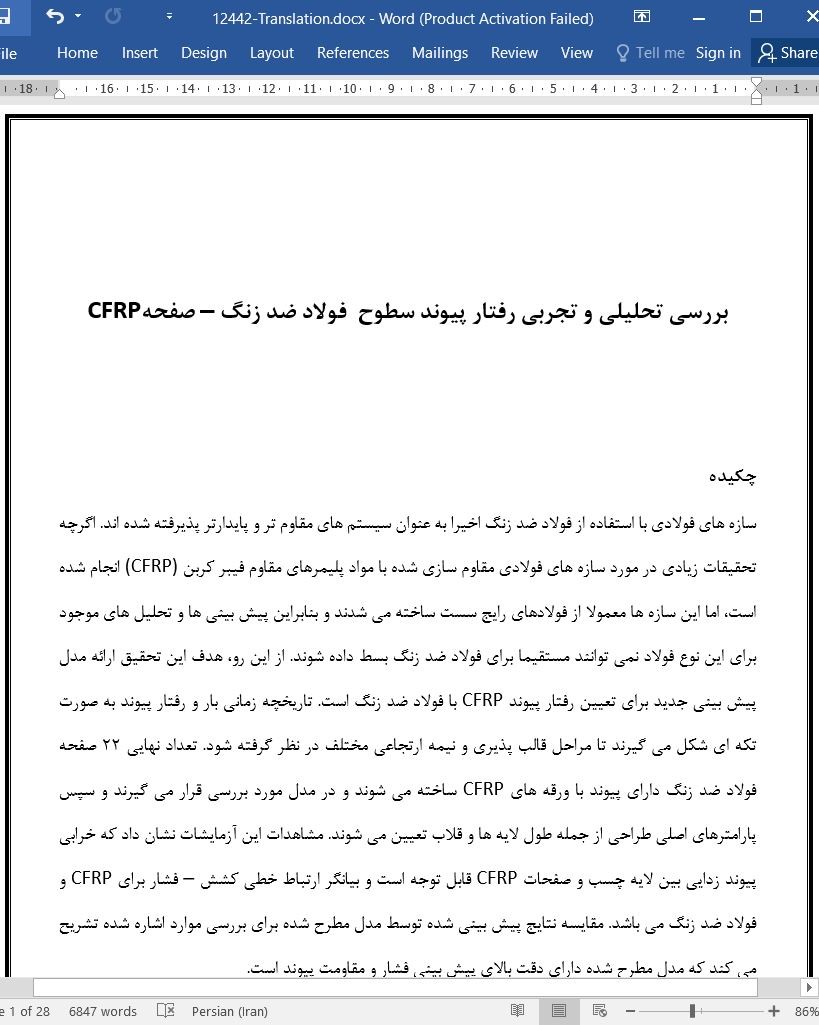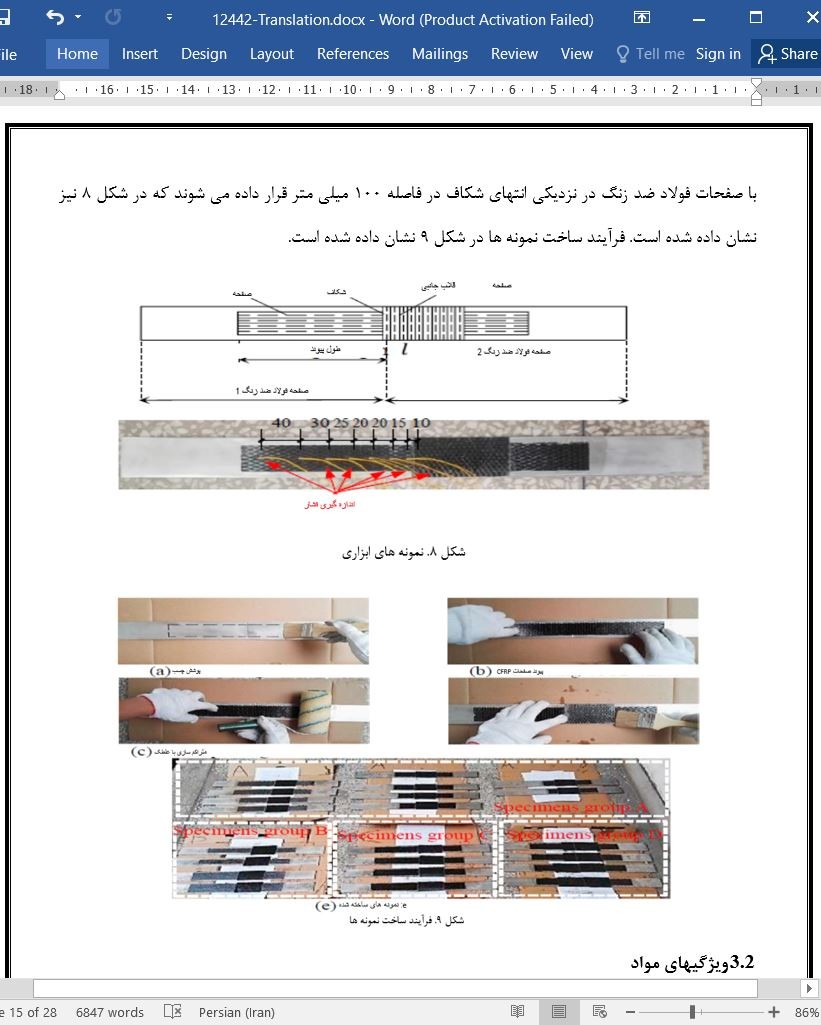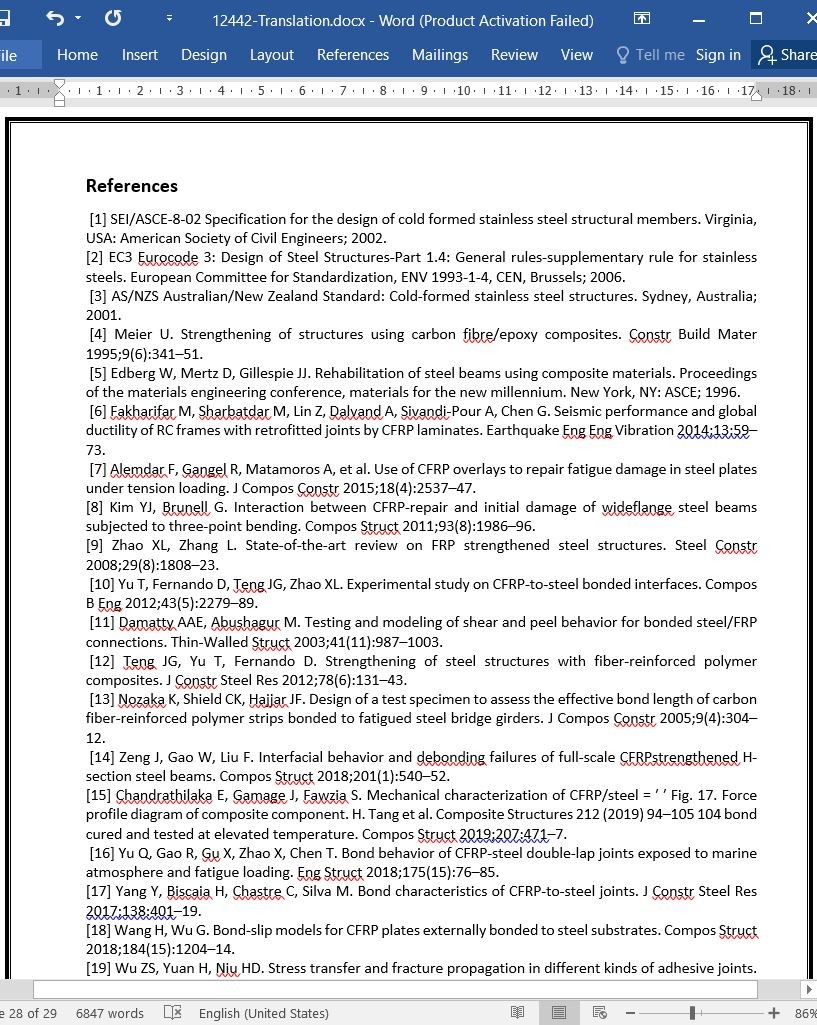
دانلود مقاله بررسی تحلیلی و تجربی رفتار پیوند سطوح فولاد ضد زنگ – صفحه CFRP
چکیده
سازه های فولادی با استفاده از فولاد ضد زنگ اخیرا به عنوان سیستم های مقاوم تر و پایدارتر پذیرفته شده اند. اگرچه تحقیقات زیادی در مورد سازه های فولادی مقاوم سازی شده با مواد پلیمرهای مقاوم فیبر کربن (CFRP) انجام شده است، اما این سازه ها معمولا از فولادهای رایج سست ساخته می شدند و بنابراین پیش بینی ها و تحلیل های موجود برای این نوع فولاد نمی توانند مستقیما برای فولاد ضد زنگ بسط داده شوند. از این رو، هدف این تحقیق ارائه مدل پیش بینی جدید برای تعیین رفتار پیوند CFRP با فولاد ضد زنگ است. تاریخچه زمانی بار و رفتار پیوند به صورت تکه ای شکل می گیرند تا مراحل قالب پذیری و نیمه ارتجاعی مختلف در نظر گرفته شود. تعداد نهایی 22 صفحه فولاد ضد زنگ دارای پیوند با ورقه های CFRP ساخته می شوند و در مدل مورد بررسی قرار می گیرند و سپس پارامترهای اصلی طراحی از جمله طول لایه ها و قلاب تعیین می شوند. مشاهدات این آزمایشات نشان داد که خرابی پیوند زدایی بین لایه چسب و صفحات CFRP قابل توجه است و بیانگر ارتباط خطی کشش – فشار برای CFRP و فولاد ضد زنگ می باشد. مقایسه نتایج پیش بینی شده توسط مدل مطرح شده برای بررسی موارد اشاره شده تشریح می کند که مدل مطرح شده دارای دقت بالای پیش بینی فشار و مقاومت پیوند است.
1. مقدمه
در سالهای اخیر- فولاد ضد زنگ - به علت رسانایی بسیار بالا و مقاومت عالی در برابر فرسایش از مواد سازه ای جایگزین مواد مورد استفاده در سازه های مقاوم تر و پایدارتر می باشند. همچنین، بعضی از کشورها از جمله کشورهای اروپایی و امریکایی، استانداردهای طراحی و قوانین خاصی را برای فولادهای ضد زنگ ارائه کردند (1-3). همانند فولاد سست قدیمی، سازه های فولاد ضد زنگ می توانند با استفاده از صفحات کامپوزیت CFRP مقاوم سازی شوند و این سازه به عنوان ماده ای موثر در سازه های مهندسی عمران پذیرفته شده است (4-9).
همان طور که قبلا بیان شده است (19و10و8)، انتخاب و طراحی درست کامپوزیت های CFRP در یک سازه ارتباط بسیار زیادی با عملکرد پیوند سطحی بین CFRP و زیر لایه های فولاد دارد که عبارتست از سطح CFRP به سطح فولاد. مرور ادبیات نشان می دهد که بسیاری از تحقیقات انجام شده از طریق آزمایشات تجربی و یا مدلسازی تحلیلی متمرکز بر رفتار پیوند بین مواد CFRP و فولاد بوده اند. از چشم انداز تجربی (10-14)، رفتار پیوند از طریق آزمون های تقویت چسبندگی FRP با اجزای فولاد سست مورد بررسی قرار گرفته اند و برای مثال می توان محققانی چون داماتی و ابوشاگور (11) را نام برد که تحقیقاتی را انجام دادند که شامل آزمایش کشش صفحات FRP دارای پیوند با فولادهای حفره دار هستند تا بتوان با انجام این آزمایش رفتار درون محوری و خارج از محور صفحات FRP را بیان کرد. تنگ و همکارانش (12) یک تحقیق تجربی انجام دادند که در آن به بررسی رفتار سطوح دارای پیوند CFRP از طریق بررسی اتصالات لولایی پرداختند.
6.نتیجه گیری
این تحقیق از طریق انجام آزمایشات تحلیلی و تجربی به بررسی رفتار پیوند صفحات فولاد ضد زنگ با CFRP پرداخته است. بعضی از نتایج به دست آمده عبارتند از:
• با تعریف چهار مرحله، مدل مطرح شده می تواند به صورت موثر تمام فرآیند پیوند فولاد ضد زنگ با CFRP را در چارچوب زمانی توصیف کند.
• مدل مطرح شده با تعریف لایه چسبناک به عنوان ماده ایده آل ارتجاعی و صفحات CFRP و فولاد ضد زنگ به عنوان ماده قالب پذیر می تواند برای پیش بینی رفتار پیوندی فولاد ضد زنگ با CFRP کافی باشد. در این مدل، مواردی چون توزیع فشار کششی و بارهای بحرانی تاثیر گذار بر چسبندگی صفحات CFRP مطرح می شود و بنابراین، فرضیه مطرح شده با استفاده از روابط خطی کشش – فشار برای CFRP و فولاد ضد زنگ تائید می شود.
• زمانی که عرض پیوند صفحات CFRP به عرض صفحات فولاد ضد زنگ نزدیک باشد و تعداد لایه های CFRP کمتر باشد، تاثیر طول پیوند و طول CFRP دارای پیوند وارونه بر توزیع فشار کششی و بارهای بحرانی کمتر است. وقتی که طول پیوند کافی باشد، افزایش تعداد لایه های CFRP بر توزیع کشش داخلی صفحات CFRP تاثیر گذار خواهد بود. بنابراین، شیب بین صفحات CFRP در لایه های مختلف همزمان نخواهد بود و این عامل بر توزیع فشار کششی و بار بحرانی تاثیر گذار خواهد بود.
• وقتی که ماده در مرحله قالب پذیری قرار می گیرد، فشار و کشش لایه چسبناک عمدتا در نزدیکی انتهای شکاف قرار می گیرد و کشش کمتری در فاصله درز از این مکان وجود خواهد داشت. وقتی که بار به وضعیت بحرانی برسد، منطقه قالب پذیری در انتهای شکاف پدیدار می شود و فشار کششی به حداکثر مقدار خود می رسد. با توسعه پیوسته منطقه ارتجاعی، این منطقه در انتهای شکاف به حداکثر مقدار خود می رسد و منطقه قالب پذیری به دورترین فاصله می رسد و طول پیوند موثر می تواند I=le+lp در نظر گرفته شود. فشار کششی در منطقه ارتجاعی به بازده (YU) می رسد. در نتیجه، لایه چسبناک نمی تواند در برابر بارهای خارجی مقاومت کند و اولین رویداد پیوند زدایی اتفاق می افتد.
• به دلیل وجود محدودیت های حاصل از فرضیه های مورد استفاده در مدل مطرح شده، انحراف بین اندازه گیری و پیش بینی در نقاط خاص ایجاد می شود. مدل پیش بینی شده می تواند اصلاح شود تا در کاربردهای بیشتر مورد استفاده قرار بگیرد.
Abstract
Steel structures using stainless steel are recently accepted as more sustainable and durable systems. Although much research has been conducted on steel structures strengthened by carbon fiber-reinforcement polymer (CFRP) material, these steel structures are often made of conventional mild steel and thus existing prediction and analysis specified for mild steel cannot be directly extended for that of stainless steel. Therefore, this study aims to develop a new prediction model for determining the bond behavior of CFRP-to-stainless steel. Load time-history bond behavior was formulated in a piecewise manner to account for varying elastic, elastoplastic and debonding stages. A total of 22 stainless steel plates bonded with CFRP laminates were fabricated and tested to calibrate the model and further quantify the critical design parameters, including layers and anchorage length. Observation of the experiment showed that debonding failure between the adhesion layer and the CFRP sheets was dominant, partially suggesting the linear stress-strain relation for the CFRP and stainless steel. Comparison of results predicted by the proposed model to the test ones demonstrated that the proposed model has a high accuracy in prediction of bond stress and bond strength.
1. Introduction
In recent years, the stainless steel, due to its excellent ductility and superior resistance to corrosion, becomes emerging structural material as alternative for more sustainable and durable structures. Accordingly, some countries, including those in Europe and the United States, have developed the relevant design codes and specifications to the stainless steel [1–3]. Similar to the traditional mild steel, the stainless-steel structures could be strengthened and retrofitted by the use of the CFRP composite sheets that have been widely accepted as effective materials in civil engineering structures [4–9].
As identified [8,10–19], the selection and proper design of the CFRP composites to a structure are highly associated with the performance of the interfacial bond between the CFRP and steel substrate, that is, CFRP-to-steel interface. Literature review reveals that most studies either through experimental tests or analytical modeling have been conducted particularly on the bond behavior between the CFRP material and steel. From experimental standpoint [10–14], bond behavior was studied through the tests of adhesion strength of FRP to the mild steel components, for instance, Damatty and Abushagur [11] carried out the experiments involving shear lap testing of FRP sheets bonded to hollow steel sections to address the in-plane and out-of-plane behavior of the FRP sheets. Teng et al. [12] has presented an experimental study on the behavior of CFRP-to-steel bonded interfaces through testing of single-lap bonded joints.
6. Conclusion
This study investigated the bond behavior of CFRP-to-stainless steel plate through both analytical model and experiment. Some conclusions can be drawn as follows.
- By defining four stages, the proposed model could effectively describe the whole load time-history bond behavior of CFRP-to-stainless steel.
- The proposed model by define adhesive layer as an ideal elasticplastic material, and the CFRP sheet and stainless steel plate as the linear elastic material could be sufficient to predict the bond behavior of CFRP-to-stainless steel, including bond shear stress distribution and crucial load associated to bond strength. The experimental observation revealed that adhesion failure between the adhesion and the CFRP sheets was dominant, and thus confirms the assumption using linear stress-strain relations for the CFRP and stainless steel.
- When the bonding width of CFRP sheets is close to that of the stainless steel plate and the number of CFRP layers is less, the effect of bonding length and length of the extra transverse bonded CFRP on the distribution of shear stress and critical load is less. When the bonding length is sufficient, increasing the number of CFRP layers will influence the distribution of the internal strain of the CFRP sheets, so that the slippage between the CFRP sheets in different layers are not synchronous, which will affect the distribution of shear stress and the critical load.
- When the specimen was in the elastic stage, the stress and strain of the adhesive layer was mainly concentrated near the seam end, and there was little strain far from the seam end. When the load reached the critical status, the plastic zone appeared at the seam end, and the shear stress achieved the maximum. With the continuous expansion of plastic zone, the elastic zone gradually moved away from the seam end. When the plastic zone of the seam end reached the maximum and the elastic zone develops to the farthest, the effective bonding length can be described as l = le +lp and the shear strain in the plastic zone achieved the yield strain (Yu). u Hereafter, the adhesive layer cannot resist the external shear load, and the first debonding occurred.
- Due to limitations from assumptions used in the proposed model, there existed deviation between the measurement and the prediction at certain points. The prediction model could be further modified to account for more widespread real-world application.
چکیده
1. مقدمه
2. فرمولاسیون رفتار پیوند CFRP با فولاد ضد زنگ
2.1 فرضیه های اصلی
2.2 تحلیل نیرو در اجزای کامپوزیت
2.3 انحراف از رابطه شیب – پیوند
3.آزمایش تجربی و محاسبات
3.1 نمونه های آزمایشی
3.2 ویژگیهای مواد
3.3 موقعیت آزمایش و ابزار مورد استفاده
4 .نتایج آزمایش
4.1 حالت های افت
4.2 فشار کشش در صفحاتCFRP
4.3 منحنی گسترش -بار برای صفحات CFRP
5. تحقیقات پارامتری بیشتر و بحث در مورد مقاومت پیوند
5.1 تاثیرات پارامترهای بحرانی طراحی تحقیق مربوط به فشار کشش پیوند
5.2 پیش بینی مقاومت بحرانی مرتبط با نیروی کشش پیوند
6.نتیجه گیری
منابع
ABSTRACT
1. Introduction
2. Formulation of bond behavior of CFRP-to-stainless steel
2.1. Basic assumptions
2.2. Force analysis of composite members
2.3. Derivation of bond-slip relation
3. Experimental test and calibration
3.1. Test specimens
3.2. Material properties
3.3. Test setup and instrumentation
4. Test results and discussions
4.1. Failure modes
4.2. Shear stress of CFRP sheets
4.3. Load-elongation curve of CFRP sheets
5. Further parametric study and discussions of bond strength
5.1. Effects of critical design parameters on bonding shear stress
5.2. Critical capacity prediction associated to bond shear stress
6. Conclusion
References
- ترجمه فارسی مقاله با فرمت ورد (word) با قابلیت ویرایش، بدون آرم سایت ای ترجمه
- ترجمه فارسی مقاله با فرمت pdf، بدون آرم سایت ای ترجمه



